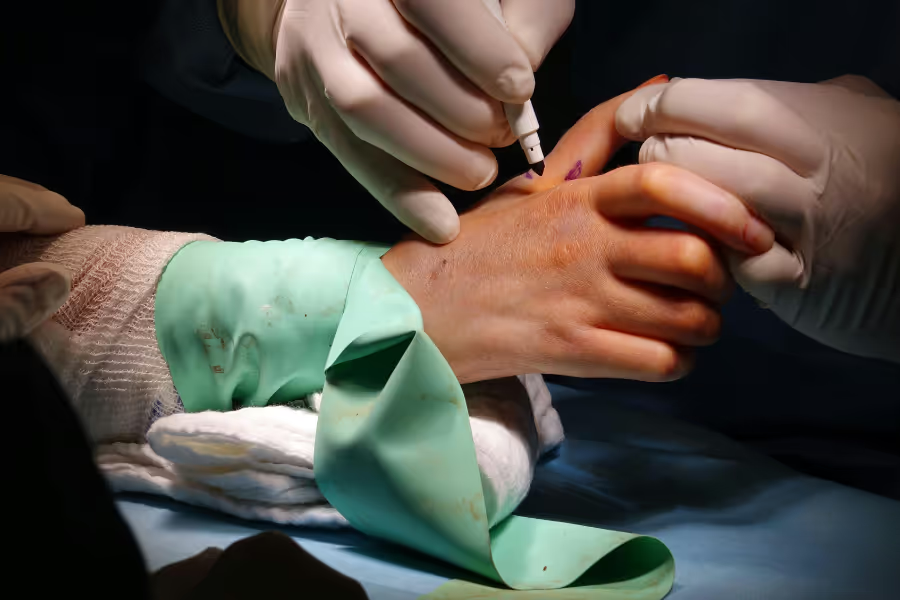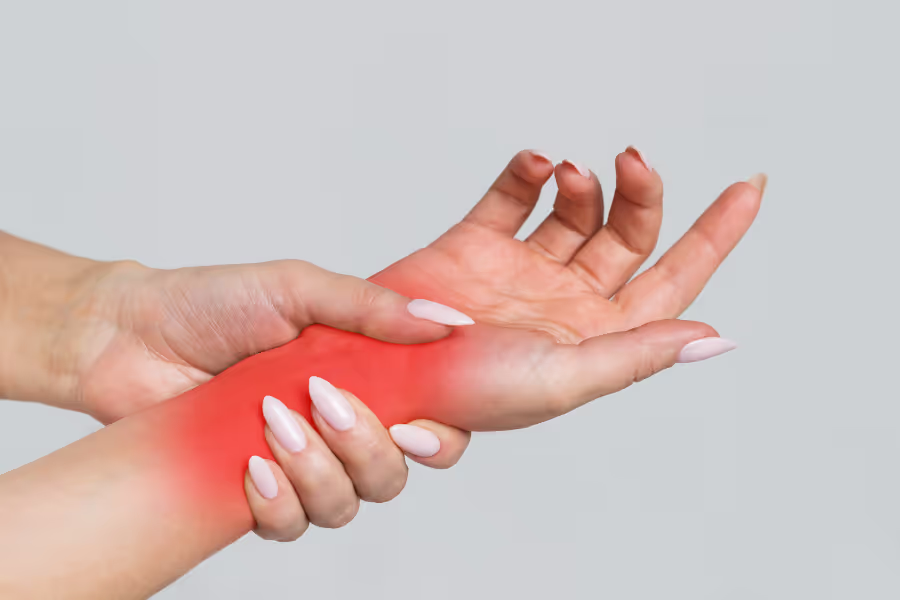Hand and wrist arthroscopy may help if persistent pain, stiffness, clicking, or locking is disrupting your sleep, sports, work, and daily activities. Learn more and find the right surgeon that fits your needs below, serving Canadians in major cities like Vancouver, British Columbia; Calgary, Alberta; Toronto, Ontario; and Montréal, Québec.
Informational purposes only, not medical or legal advice. Please consult your doctor or surgeon.

Hand and wrist arthroscopy is a “keyhole” surgery that lets doctors look inside small joints using a tiny camera and tools. Instead of a big cut, the surgeon makes a few mini incisions and slides in an arthroscope—a pencil‑thin camera that shows a magnified, real‑time view on a screen.
Through other small portals, they use micro‑instruments to diagnose and treat problems with precision.
Because the camera sees details that imaging can miss, arthroscopy is especially useful when symptoms suggest something mechanical inside the joint—like catching, clicking, or localized pain—and the surgeon needs a direct look to confirm the issue and perform delicate fixes without disturbing a lot of healthy tissue.
Hand and wrist arthroscopy can face long queues. Instead of waiting months for consultation and OR time, private centers can often schedule surgery within weeks—reducing time spent with catching, clicking, or persistent pain, and helping you get back to writing, typing, work, or sport sooner.
Going private gives you more say in your care. You can:
Patients value knowing exactly who will operate, when it will happen, and the detailed plan (targets on arthroscopy, anesthesia approach, rehab milestones). Clear timelines ease anxiety and give you the certainty you need to plan schedules, coordinate support, and take time off work.

Most hand or wrist arthroscopies take about 30–60 minutes (some simpler ones are even quicker). Plan on a few extra hours for check‑in, anesthesia, and recovery before you go home.
Basic steps:
Your surgery may look different. Consult your surgeon.

Your exact plan comes from your surgeon and can vary. Take rehab seriously—the more consistent you are, the better the outcome. Some private clinics offer virtual follow‑ups or coordinate local physio.
In general, what to expect after Hand and Wrist Arthroscopy:
Week 1
Reality check: soreness, swelling, stiffness, awkward sleep. Not fun.
Goals: control pain/swelling, protect the scope sites, start gentle safe motion.
Activities:
Weeks 2–4
Still puffy but improving.
Goals: restore range of motion (ROM), reduce swelling, use the hand lightly.
Activities:
Weeks 5–12
The work phase.
Goals: near‑full ROM by ~8–10 weeks; begin strength and coordination.
Activities:
Weeks 13–52
Back to real‑world function.
Goals: full or near‑full motion, strength, and endurance; confident use for school, work, music, or sport skills.
Activities:
Red flags anytime: fever, worsening redness/drainage, severe swelling, chest pain/shortness of breath, new numbness/weakness—contact your care team.
Hand and wrist arthroscopy is a minimally invasive surgery, however the costs are significant and very because of the potential complexity involved in certain instances. Private clinics in Canada typically charge $6,000 to $9,000.
In the United States, the average cost is CA$4,200 to CA$9,400.
Costs vary so much because of location, surgeon experience, facility type, scope of potential treatments, complexity of the issue, and included services (some clinics offer all-inclusive, while others charge separately for anesthesia, followup care, etc.).
Choosing your surgeon is one of the benefits of going the private route. Here’s what to consider and the key questions to bring to your hand or wrist arthroscopy consultation.
Hand and wrist arthroscopy is a minimally invasive surgery where the surgeon uses a tiny camera and tools to look inside your joint and fix specific problems. It might be right for you if:
No, you do not need a referral for private hand and wrist arthroscopy in Canada. You can book a consultation directly with a surgeon, and they will review your condition, symptoms, and any previous treatments or diagnostics.
Your surgeon will tailor instructions based on your exact procedure (e.g., TFCC debridement/repair, loose body removal, synovectomy, ligament assessment/repair).
Pre-surgery exercises: Expect gentle range-of-motion for fingers, wrist (if comfortable), elbow, and shoulder to reduce stiffness. Light grip, forearm, and scapular activation may be advised. If a repair is planned (e.g., TFCC), avoid provocative motions until surgery.
Quit nicotine: Stop smoking/vaping/chew at least 4+ weeks before surgery—nicotine increases wound problems and stiffness risk.
Weight, sleep, nutrition: Balanced diet with adequate protein, good sleep, and hydration help healing.
Medications: Share a full list of meds/supplements. You may need to pause blood thinners, certain NSAIDs, or herbal supplements that increase bleeding—only with your surgeon/doctor’s approval.
Pre-op testing: You may need updated imaging or medical clearance depending on your health.
One-handed setup: After surgery you’ll have a bulky dressing or splint and limited use of the operative hand. Organize your space so essentials are easy to reach and open.
Safety first: Remove tripping hazards (cords, sliding rugs, clutter). Keep walkways clear.
Bathroom: Consider a shower chair, non-slip mat, and pump soaps. Place towels, toiletries, and clothes at reachable height. A detachable showerhead helps.
Comfort station: Set up a chair/bedside area with pillows to elevate the hand above heart level, plus ice/cold packs, water, phone/charger, and meds.
Clothing: Choose loose sleeves, front-opening tops, and easy-on bottoms. Slip-on shoes are helpful.
A helper: Arrange a ride home and someone to stay the first 24–48 hours. Have a backup contact for the first couple of weeks.
Work/school/chores: Plan time off. Desk work may resume sooner than manual work, but you’ll need time for swelling control and early therapy. Line up help for cooking, cleaning, childcare, and pet care for a few days.
Driving: You generally can’t drive with a numb/immobilized hand—arrange transportation.
Fasting: Follow anesthesia instructions exactly (no food after the cutoff; clear fluids as allowed). Many cases use regional anesthesia plus sedation.
Skin prep: Use the antiseptic wash (e.g., chlorhexidine) the night before and morning of surgery. Do not shave the operative arm.
What to bring: Photo ID, medication list, loose top with wide sleeve, and your splint/brace if pre-issued.
Jewelry and nails: Remove rings/bracelets/watches from the operative side. Keep at least one fingernail free of heavy polish/acrylic for monitoring.
Pain plan: You may receive a nerve block that numbs the arm for 8–24 hours. Fill pain prescriptions beforehand and have acetaminophen ± NSAIDs (if approved) ready. Take the first dose before the block wears off.
Nausea/constipation: Ask for anti-nausea meds if you’ve had issues. Have stool softeners/fiber on hand—pain meds can constipate.
Swelling control: Elevate the hand above heart level frequently and use ice/cold therapy as directed. DVT risk is low for hand surgery, but keep moving your legs, and walk short distances as you’re able.
One-handed routines: Practice dressing, bathing, meal prep, opening containers, and phone/computer use with your non-operative hand.
Elevation and protection: Rehearse resting positions that keep the hand elevated and avoid bumping it during sleep.
Kitchen hacks: Pre-open jars, prep single-serve meals/snacks, and set up lightweight cups/plates.
Your own situation depends on your pain level, how much motion/strength you’ve lost, what imaging shows (TFCC tear, ligament injury, loose bodies, cartilage wear, synovitis), your daily/sport demands, and how well non‑surgical care works (splinting, therapy, activity changes, meds, injections). Discuss specifics with your surgeon.
Your individual risk depends on your health, wrist/hand anatomy, the exact problem being treated (TFCC tear, loose bodies, synovitis, ligament injury), the surgical approach, and how well you follow the rehab plan. Discuss your specific risks with your surgeon.
If you still have questions, then feel free to contact us directly.

Browse vetted hand and wrist surgeons across Canada. Compare prices, qualifications, locations.
BROWSE SURGEONS